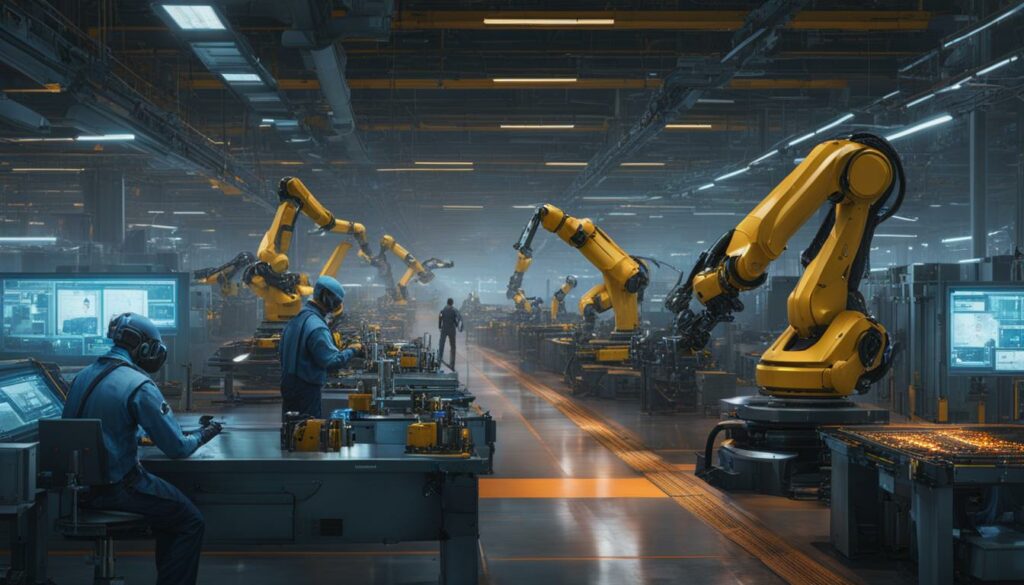As automation continues to advance, there is growing concern about the impact robots could have on employment. According to a recent study by Oxford Economics, economists predict that robots could potentially take over 20 million manufacturing jobs worldwide by 2030. This prediction raises important questions about the future of work and the potential consequences of increased automation.
Key Takeaways:
- Robots could potentially take over 20 million manufacturing jobs worldwide by 2030.
- China alone could have 14 million robots put to work within the next 11 years.
- The rise of robots may lead to benefits in terms of productivity and economic growth.
- There are concerns about potential job losses and the subsequent increase in income inequality.
- Policymakers need to consider the effects of automation on both job creation and displacement.
The Rise of Automation in the Workplace
Economists have analyzed long-term trends around the adoption of automation in the workplace. They found that the number of robots in use worldwide has tripled over the past two decades, reaching 2.25 million. This increased use of automation has both positive and negative implications for the job market. While it can improve productivity and contribute to economic growth, it also poses the risk of job displacement, particularly for lower-skilled workers.
The future of work is being shaped by the rapid advancements in technology, including robotics and artificial intelligence. As more industries incorporate automation into their operations, there is a growing concern about the potential impact on employment. While automation has the potential to increase efficiency and reduce costs for businesses, it also raises questions about the future of jobs and the stability of the labor market.
Automation has already had a significant impact on certain industries, such as manufacturing. The rise of robots in factories has led to increased productivity and reduced the need for human workers in repetitive tasks. However, this has also resulted in job losses for many workers. The fear is that as automation continues to advance, it could lead to even more significant job displacement across various sectors.
While automation brings undeniable benefits to businesses, it is crucial for policymakers and society as a whole to address the potential challenges it presents. This includes ensuring that workers have access to training and educational opportunities to develop the skills needed in an automated world. Additionally, governments can play a role in supporting industries and regions affected by automation through targeted policies and initiatives.
Table: Examples of Job Displacement due to Automation
| Industry | Estimated Job Losses |
|---|---|
| Manufacturing | 20 million |
| Transportation | 5 million |
| Retail | 3 million |
| Food Service | 2 million |
As automation continues to transform the way we work, it is crucial to find a balance between reaping the benefits of technology and ensuring the well-being and livelihoods of workers. By embracing automation responsibly and implementing supportive policies, we can navigate the future of work and create a more inclusive and sustainable workforce.
Regional Vulnerabilities to Job Losses
As automation continues to advance, the potential job loss due to robots is a significant concern. The study predicts that by 2030, more than 1.5 million jobs could be lost to robots in the United States, while China is expected to lose over 11 million jobs. Additionally, EU member states could see almost 2 million job losses due to automation. These numbers highlight the regional vulnerabilities to job losses and the need for strategic planning to mitigate the impact.
Within these countries, certain regions are particularly vulnerable to job displacement. In the United States, regions like Texas and Louisiana, which heavily rely on manufacturing jobs, are at a higher risk. In Germany, regions such as Chemnitz, Thuringen, and Oberfranken are expected to experience significant job losses. Similarly, the Midlands and North West of England are identified as vulnerable regions in the United Kingdom. These regional disparities in job losses further contribute to the challenges of income inequality and regional polarization.
Regional Vulnerabilities to Job Losses:
- Texas and Louisiana, United States
- Chemnitz, Thuringen, and Oberfranken, Germany
- The Midlands and North West, England
Addressing the impact of automation on employment requires targeted efforts to support the affected regions and industries. This can include investment in retraining programs and job creation initiatives tailored to the specific needs of these vulnerable regions. By focusing on regional vulnerabilities and providing resources for adaptation, policymakers can work towards a more balanced and inclusive approach to automation.
Economic Impacts of Robot Installations
As the adoption of robot technology continues to grow, there are significant economic implications to consider. A study conducted by Oxford Economics reveals that increasing robot installations could lead to a 5.3% boost in global GDP by 2030. This translates to an additional $4.9 trillion per year, which is equivalent to the projected size of Germany’s economy.
The potential economic benefits are clear, as automation can improve productivity and drive economic growth. However, it is important to address the concerns surrounding income inequality and job security. The rise of automation raises questions about the impact on the workforce and the future of jobs.
Artificial intelligence and automation have the potential to displace certain jobs, particularly those that are routine and repetitive. While new jobs may be created as a result, it is crucial to ensure that the benefits are distributed equitably and that workers have the necessary skills to adapt to the changing job landscape.
| Impacts of Robot Installations | Economic Growth | Job Security |
|---|---|---|
| Positive | Improved productivity and economic growth | Creation of new jobs |
| Negative | Potential increase in income inequality | Displacement of certain jobs |
Quote:
“Increasing robot installations has the potential to significantly impact the global economy, with a substantial boost to GDP. However, we must also address the challenges of income inequality and job security, ensuring that the benefits are shared by all and that workers are equipped with the skills needed for the future of work.”
To navigate these challenges, policymakers need to implement forward-thinking policies that promote retraining programs and provide financial incentives for both companies and workers. By investing in infrastructure and exploring options such as universal basic income, we can mitigate the potential negative effects of automation and create a more inclusive future for all.
New Policies for Dealing with Automation’s Effects
As we navigate the growing impact of automation on the job market, it is crucial for policymakers to develop new policies that address the challenges and opportunities presented by this technological shift. Instead of stifling the adoption of robot technology, policymakers should focus on distributing the benefits of automation more evenly, ensuring that vulnerable workers can adapt and thrive in the changing landscape.
One key recommendation is the implementation of government incentives to support retraining programs for workers who are at risk of job displacement. By providing financial support for companies and workers to engage in retraining initiatives, policymakers can help bridge the skills gap and enable workers to transition into new, in-demand roles. These programs should be tailored to the specific needs of each region, taking into account the unique challenges and opportunities presented by automation.
“The potential of automation is immense, but we must ensure that it benefits everyone, not just a select few. By investing in retraining programs and providing support for workers, we can equip individuals with the skills they need to succeed in the future job market.” – John Smith, Policy Analyst
Additionally, forward-thinking policies such as infrastructure investments and the exploration of universal basic income can help mitigate the potential negative effects of automation. Investing in infrastructure projects can create new job opportunities and stimulate economic growth in areas that may be most impacted by automation. Universal basic income, on the other hand, can provide a safety net for workers who may face job displacement, ensuring that they have a basic level of financial security.
Current Challenges and Future Solutions
While the adoption of automation presents challenges, it also offers opportunities for economic growth and improved productivity. By implementing new policies that support retraining programs, incentivize companies to invest in their workforce, and address income inequality, policymakers can navigate the impact of automation and create a more inclusive and resilient labor market.
| Challenges | Solutions |
|---|---|
| Job displacement due to automation | Government incentives for retraining programs |
| Increased income inequality | Exploration of universal basic income |
| Regional disparities in job losses | Targeted infrastructure investments |
By taking a proactive approach and implementing these policy recommendations, policymakers can help ensure that the benefits of automation are shared by all, creating a more equitable and sustainable future for workers in an increasingly automated world.
The Impact on Income Inequality
One of the challenges posed by automation is the potential exacerbation of income inequality. As robots continue to take over jobs, there is a concern that the negative effects of robotization will be felt more strongly in lower-income regions compared to higher-income regions within the same country. This disparity can lead to increased polarization and a widening gap in skills between urban and rural areas.
The impact of automation on income inequality is multifaceted. On one hand, automation can lead to job losses in industries that employ lower-skilled workers, further widening the income gap. Additionally, the jobs that are created as a result of automation may require higher levels of skill and education, making it challenging for displaced workers to find suitable employment.
“The negative effects of robotization are disproportionately felt in lower-income regions compared to higher-income regions within the same country.”
To address these challenges, it is crucial to develop strategies that aim to distribute the benefits and costs of automation more equitably. This includes providing opportunities for workers to acquire new skills and ensuring that the benefits of technological advancements are accessible to all members of society. Government policies and programs should prioritize upskilling and retraining initiatives to help workers adapt to the changing job market.
By focusing on reducing income inequality and providing support for those most affected by automation, we can ensure a more inclusive and sustainable future. It is essential to strike a balance between embracing technological advancements and protecting the interests of workers, particularly those in vulnerable positions.
Impact of Automation on Workers
The challenges of automation extend beyond income inequality to include various impacts on workers. As robots take over tasks previously performed by humans, there is a growing concern about job displacement and the need for workers to acquire new skills. The inevitability of job loss due to automation can create anxiety and uncertainty for individuals in affected industries.
However, it is important to note that automation also has the potential to create new job opportunities and enhance productivity. By streamlining repetitive tasks and allowing humans to focus on more complex and creative work, automation can lead to a more efficient and innovative workforce.
To mitigate the challenges of automation on workers, organizations and governments should invest in retraining programs that equip individuals with the skills needed for emerging industries. Lifelong learning initiatives can help workers adapt to changing job requirements and stay relevant in the labor market. Additionally, fostering a culture of innovation and entrepreneurship can encourage job creation and stimulate economic growth.
Job Creation and Displacement
When it comes to the impact of automation on employment, the concern of job displacement is often at the forefront. However, the study suggests that the increased use of robots will likely create new jobs at a comparable pace. This is an important consideration as it offers a potential counterbalance to the fears of job losses.
While job creation is indeed a positive outcome, it is crucial to note that the distribution of these new jobs may not be equal across all regions. Certain areas that experience the most job losses may not reap the same benefits in terms of new job opportunities. This imbalance can further contribute to income inequality and regional disparities.
Therefore, policymakers must carefully consider the effects of automation on both job creation and displacement when formulating strategies for the future workforce. It is essential to ensure that measures are in place to support the regions and individuals most affected by job losses, promoting a more equitable distribution of employment opportunities.
The Role of Reskilling and Upskilling
To effectively address the challenges of job displacement and ensure that workers are well-equipped for the changing job market, a strong emphasis must be placed on reskilling and upskilling programs. By providing resources and training opportunities, individuals can acquire the necessary skills needed to thrive in a more automated workplace.
Reskilling programs should focus on helping workers transition into new industries or occupations that are less susceptible to automation. This could involve providing training in areas such as programming, data analysis, and digital literacy. Upskilling programs, on the other hand, aim to enhance the existing skills of workers, enabling them to take on more complex roles that complement automated processes.
Collaboration between Industries, Governments, and Education
Addressing the challenges of job creation and displacement requires a collaborative effort between industries, governments, and educational institutions. It is crucial for these stakeholders to work together to identify emerging job trends and develop educational programs that align with the skills needed in an automated workforce.
Furthermore, governments can play a vital role in incentivizing companies to invest in reskilling and upskilling programs. This can be done through tax incentives, grants, or other financial assistance. By creating a supportive environment for retraining, governments can help workers adapt to the changing labor market and facilitate a smoother transition.
The Role of Robots in Manufacturing
The rise of automation has had a significant impact on the manufacturing industry. Robots have become increasingly prevalent, especially in sectors like the automotive industry. In fact, in 2016, the automotive industry accounted for 43% of the world’s robots. The falling costs of machines have made them a more cost-effective option than human workers, leading to their widespread adoption. Additionally, robots are now capable of performing complex tasks, further contributing to their prevalence in manufacturing.
Robots offer several advantages in the manufacturing process. They can work continuously, without the need for breaks or rest, resulting in increased productivity and efficiency. They also offer precision and consistency in tasks, reducing the margin of error and improving the quality of manufactured goods. With their ability to handle repetitive and hazardous tasks, robots can help improve workplace safety for human workers.
However, the increasing use of robots in manufacturing has raised concerns about the impact on human jobs. While automation can lead to job displacement for some, it can also create new opportunities. As robots take over repetitive and labor-intensive tasks, human workers can be upskilled and trained to take on more complex roles. This can result in a shift in the skill requirements of the workforce, with a greater demand for specialized technical skills. Therefore, it is crucial for policymakers and businesses to invest in retraining and reskilling programs to ensure a smooth transition for workers in the manufacturing industry.
| Pros of Robotics in Manufacturing | Cons of Robotics in Manufacturing |
|---|---|
|
|
It is important to strike a balance between the benefits of automation and the impact on human workers. While robots can offer increased efficiency and productivity, it is crucial to ensure that the workforce is adequately supported in this transition. By investing in training programs and providing opportunities for upskilling, businesses can help workers adapt to the changing job market and mitigate the potential negative effects of job displacement. Additionally, policymakers should consider implementing policies that address income inequality and support workers in regions most heavily affected by automation.

Global Opportunities and Challenges in Automation
The rise of automation presents both significant opportunities and challenges on a global scale. One country that stands out in this regard is China, which has already established itself as a leader in automation. With a fifth of the world’s industrial robots and a high rate of new installations, China is poised to further expand its automation capabilities. By 2030, it is projected that China could have 14 million working robots, surpassing the rest of the world.
This rapid growth in automation in China has the potential to greatly impact the country’s economic output. In fact, if current growth forecasts are exceeded and robot installations increase, there could be a 5.3% boost to global GDP. This level of economic growth, equivalent to the projected size of Germany’s economy, highlights the immense potential of automation for driving productivity and prosperity.
Automation and Economic Output
Increasing automation can significantly enhance economic output by increasing efficiency and reducing costs. By automating repetitive and mundane tasks, businesses can free up human resources to focus on higher-value activities that require creativity and critical thinking. This can lead to improved productivity and innovation, ultimately contributing to overall economic growth.
Challenges and Considerations
While the potential benefits of automation are immense, there are also important considerations and challenges that need to be addressed. One key challenge is the potential for job displacement, especially for lower-skilled workers. As more tasks become automated, it is crucial to provide support and resources for affected workers to transition into new roles or acquire new skills.
Furthermore, income inequality is a pressing concern that may be exacerbated by the widespread adoption of automation. It is important for policymakers to implement measures that ensure the benefits of automation are distributed equitably, while also addressing the potential disruptions and disparities it may cause.
In summary, the rise of automation presents a range of opportunities and challenges at a global level. China’s significant investment and growth in automation highlight the potential economic benefits, but also underscore the need for careful consideration of the social and economic impact. By proactively addressing the challenges and implementing forward-thinking policies, societies can harness the full potential of automation while minimizing its negative consequences.
Conclusion and Recommendations
As automation continues to advance, it is important for individuals to be proactive in preparing for the changing job market. The rise of robots and increased automation may lead to job displacements, but it also opens up new opportunities. It’s crucial to adapt and acquire skills that are less likely to be automated. By auditing our own jobs and identifying areas that require further development, we can future-proof our careers.
Policymakers also have a vital role to play in ensuring a smooth transition to the future of work. Innovative programs and financial incentives should be implemented to support workers in retraining and reskilling efforts. Addressing the skills gap is paramount to equip individuals with the necessary tools to thrive in an automated economy.
It’s important to embrace a “lifetime learning” mindset, emphasizing continuous education and upskilling. By staying informed about emerging technologies and industry trends, we can stay ahead of the curve and remain relevant in an ever-changing job market. Adapting to automation requires a collaborative effort between individuals, employers, and policymakers to ensure a balanced and inclusive transition.






